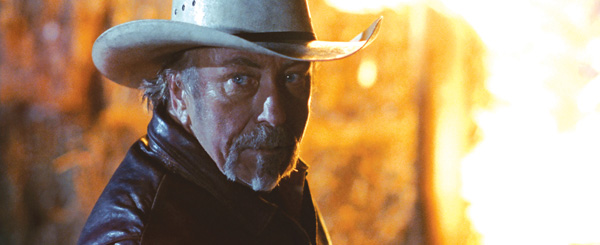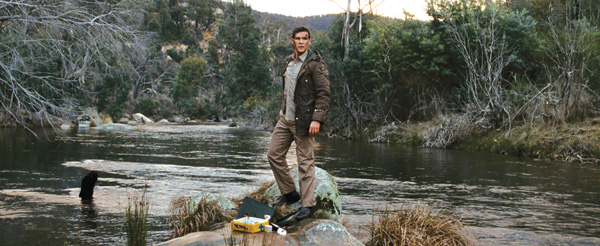
Director Patrick Hughes started production on ‘Red Hill’ with no distributor, a small budget and little planning for visual effects. His post team consisted of an editor, a VFX Supervisor, a DI colourist and a few effects artists located in different cities. But he knew that he had terrific story, set in the evocative Australian High Country, and was determined to shoot it on 35mm film.
 |
|---|
  |
|
Because he also knew his budget wouldn't stretch to shooting the entire project on new film, he located a supplier of short ends - second-hand film stock left as partly-used rolls from other productions – in Los Angeles, and got started. As a further cost saving he shot the film with a 2-perf camera, hired as part of his kit from Panavision Australia, a regular 35mm camera using regular 35mm film and regular spherical, not anamorphic, lenses but employing a modified gate and modified pull-down movement. Instead of shooting a 35mm frame that is four sprocket-hole perforations tall, it shoots a frame that is still 35mm wide, in fact Super 35mm wide, but is only two perfs tall and consequently saves half the film stock. First Cut After the first edit, however, the total length was still too long. Because the way the film had been shot, and the script itself, didn't offer many opportunities to simply lift material out, on-set VFX Supervisor Kelly Sheeran, who also logged and assembly edited the rushes each day for continuity, helped them shorten individual shots, sometimes changing the dialogue to get to the point of a scene more quickly and splitting the shot through the middle. When Ben started working on the film, the only visual effects sequence the director had planned involved a marauding panther stealing into a barn at night where the hero is trying to hide from a party of gunmen. The panther had been shot as an element in Los Angeles, but without the benefits of a light controlled environment, green screen or tracking markers. The shoot had taken place in daylight outdoors in a paddock, in front of a light coloured background. At this early stage, when Patrick anticipated there would only be 12 shots to complete, Iloura's VFX Supervisor Julian Dimsey had agreed to take on this and all VFX shots for the film. Call to Action Faced with a number of shots to complete, Ben began organizing artists to turn the work around as rapidly as possible. Iloura's shot count rose to nearly 100, but because they were already engaged on other films Julian couldn't allocate any further staff. Kelly Sheeran took on 40 shots himself, and Ben put out a general email request for assistance via the Digital Labourers Federation, or DLF, a non-profit social group and contact point for people working in the digital arts. He invited interested artists, between projects, for example, to pick up a few of the remaining shots. His message drew an enthusiastic response, despite the production's shortage of time and money. Several applicants knew Patrick from working with him on his many commercial projects. A few even had appropriate elements such as blood splatters in their libraries and could be ready quickly. Ben eventually sent out shots as QuickTime files to about 10 different artists, with a reference and the scans – and got them back within a week. Stormy SkiesDirector of Photography Tim Hudson had beautifully captured the distinctive High Country location around Omeo in Victoria, but the story involves an imminent storm, requiring the addition of dramatic skies to support the narrative, including distant rumbling clouds with internal lightning. Iloura's sky replacements were composites of matte paintings combined with 3D lightning and clouds generated with Fume. "I made sure to use some of the original sky," said Julian. "Replacements seldom work well when they totally replace a sky because, of course, the foreground will be lit with the original light." His team also built a communications tower from real and CG elements, which collapses in the course of the story. "The tower is never seen breaking up - it was just a before and after scenario," explained Julian. "Before, it was completely built in CG and after we used a mixture of real and CGI, so it was a straightforward exercise for us. We took 50 or so 360 angle reference shots on location in afternoon and evening light, all taken from the ground and from the angle that the director and DP planned to shoot the collapse of the tower. We used 3ds Max to model the tower and V-Ray for rendering. On the Prowl The story of 'Red Hill' takes place over the course of one night, during which the camera looks up several times at a full moon. "These shots were composited together from a single 10 second shot of the moon, captured one night," Ben said. However, Jimmy Conway's tragically scarred face was achieved through practical effects. A new prosthetic face, created by Justin Dix at Wicked of Oz special effects studio, was brought in each day from Sydney. Fuelling the Fire They looked through the material and decided it would have been better to have shot wide at certain shots, so when capturing the pickups they also shot some elements to build wide shots with, by expanding on existing medium shots through compositing. The horses you see approaching the barn and then running away, for example, were shot well after the main shoot, about three weeks before the movie was finished. "Fuel's compositors did some excellent work. We tried to keep the shots fairly straightforward, marrying a foreground and background plate with roto, and the night setting would have helped with the various roto masks, but it was seamless. In the end, Patrick created the ending he wanted," said Ben. The movie's VFX contributors were mainly artists Patrick had engaged on his various commercial projects over the years. Ben said that his talent and energy could be infectious and enabled him to rally support for the film on short notice and within the limited budget. He also remarked that it was one of the few projects shot on film that he has worked on in the last few years. A Long Shot"DP Tim Hudson handled the long sustained landscape shots beautifully, and many were kept in the edit intact, forming an integral part of the story. He locked off shots or used gentle deliberate camera moves on wide, long lens shots. There was no handheld or even Steadicam work, a bold move in modern films where the trend is for fast paced, rapid editing. It can actually be difficult for an editor to find a comfortable exit point or manage continuity on the longer shots, and they may test the audience's patience. |
|
|
 | ||
|---|---|---|
  | ||
|
"But Patrick also wanted the shooting and editing style to convey the slow mood of the town and develop the protracted waiting aspect of the story to build tension. At times I had no alternative but to use those slow panning shots, or the long wide views of Cooper labouring uphill on his horse – Patrick had shot nothing else." Ben pointed out that the project's abbreviated time frame had a final impact on the editing, which continued until the last moments. "Two shots were actually changed in the grading suite at Digital Pictures after the Berlin screening. One shot was moved and another was shortened. But it made all the difference, and that's the advantage of digital mastering. Since you haven't cut any negatives, last minute fixes are relatively easy to make to the DCP." Mix and Match "The major issues were the different 35mm stocks used, different grain structures and particular characteristics. The use of short ends meant that some of the stock had some colour bias or contamination that needed match grading to the majority stock used in certain scenes. We approached it scene by scene by choosing certain shots as the reference for the other shots in terms of image structure and range. We did a match grade on the 'odd one out' stocks within the sequences, correcting colour bias and density, to work with the surrounding shots. The scenes were then approached as normal in the grading process. The correction trim was live and remained live in order to fine tune the match within the context of the creative grade. "There were only 3 different stocks, Kodak 5217 vision2 200T, 5218 vision2 500T and 5219 Vision3 500T, chosen according to scene requirements, but the difference here was that the stocks were of differing age and quality as they were short ends. I spent a week on the balance grade, including match grading, a typical amount of time for a balance pass on a feature. The tools in Lustre allowed me to address the match grade while doing the balance pass." Crafted Images Brett agreed with Ben that virtually all of the environmental beauty was captured in camera on the day. "We enhanced these shots and crafted them to get the most out of the principle photography, enhancing the skies to a degree using windows and vignetting, slight hue changes to the foliage or landscape to fit within the colour palette of the scene. The average viewer certainly wouldn't notice the changes but they make the shot more dramatic. "We pulled keys and did matting on a large number of shots, again, more to craft images than fix them. Keys were used to correct things like skies, roads, clouds, a character's face and wardrobe, that kind of thing. Masks and windows were utilised to subtract or add light where needed. We tracked mattes to vehicles and moving wide shots to correct certain objects or structures and to help with continuity." Flashback The extensive fires featuring in the night shots of the latter part of the film brought different considerations. "The biggest challenge was keeping the warmth and flicker of the firelight constant within the scene. There were shots where we added warmth to shots that might have been too cool. This kept the continuity tighter and the scenes flowed more easily. We added warmth to some close up shots of characters, particularly the highlights on faces, achieved through luminance keys and some animated masking. Colour Coordinated "The work Iloura did on the panther sequence was incredible, considering the plate elements they had to work with. They did all the seating of the panther within the scene, and the grade applied to the shot married it all together just a fraction more. We did need to apply grades to VFX elements like screen inserts and some of the barn burning sequence, which is normal procedure and easily achieved using keys and mattes. In the burning barn scene, we keyed the flame elements to achieve continuity between the hues of the flames in the scene. |
||
| Words: Adriene Hurst Images: Courtesy of Sony Pictures | ||
| ||




















